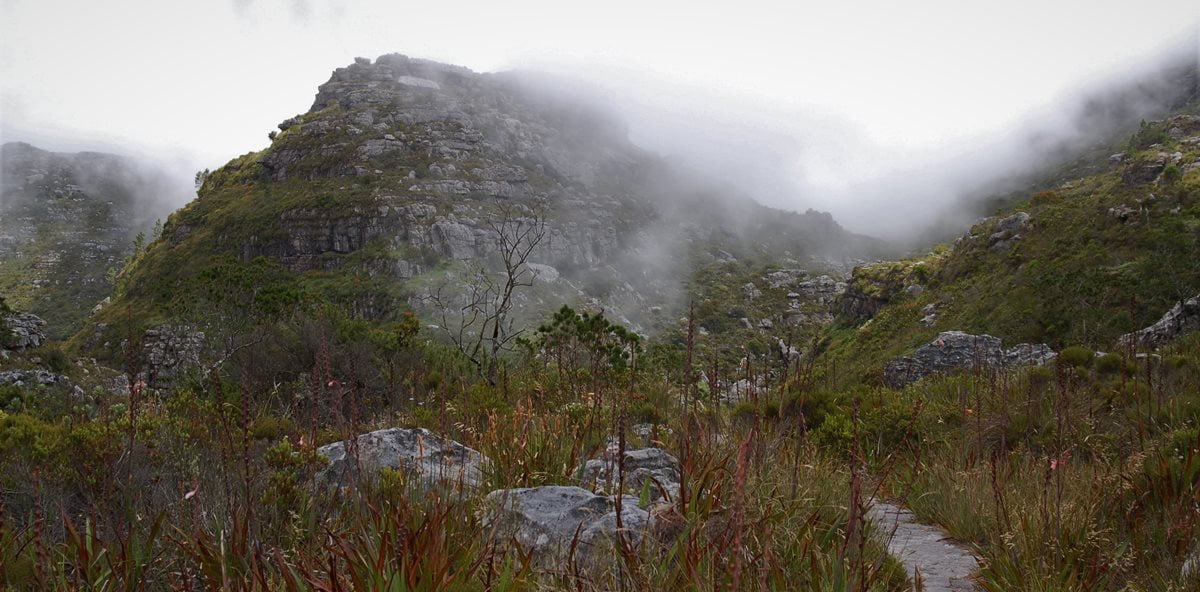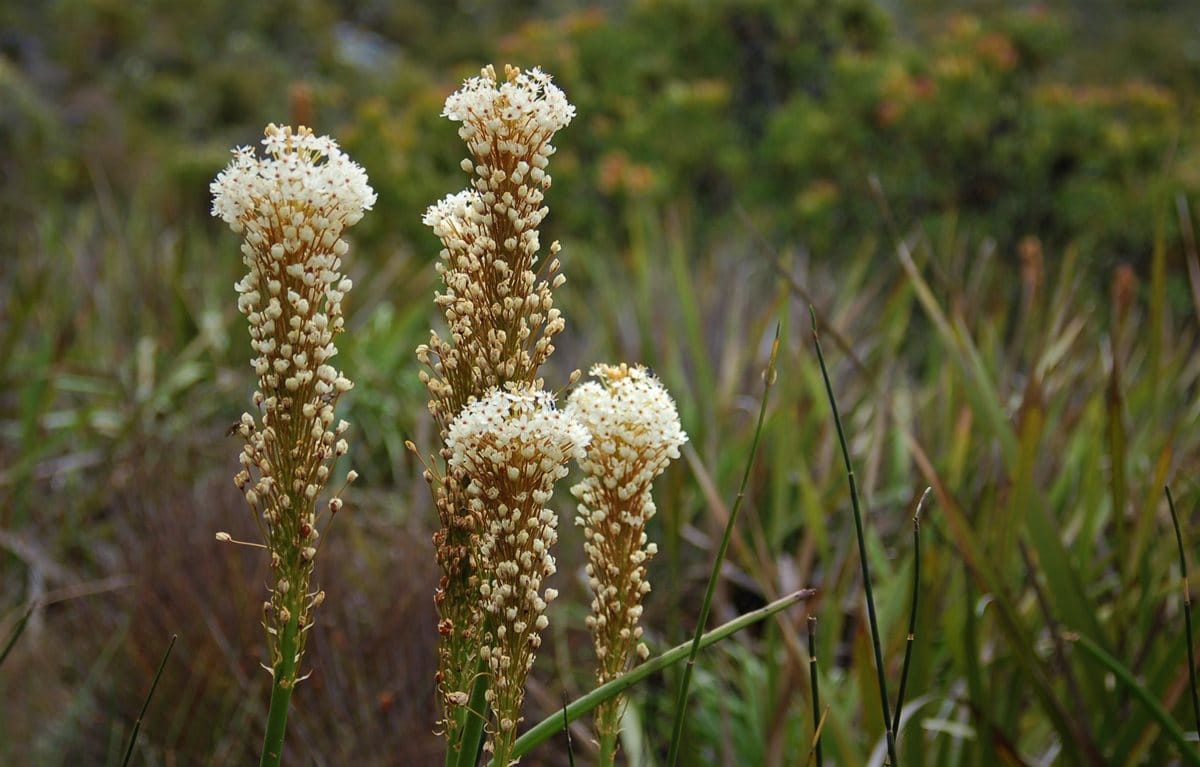Typical. You come all the way to Cape Town for a summer holiday and what happens? The wind blows so hard you lose your favourite hat. Oh, it’s bright and sunny alright, but the beaches are filled with flying sand and the ocean has been whipped up into a frothing ice-blue cappuccino. And to top it all, Table Mountain is buried under thick white cloud – the Table Cloth.

Propelled by a screaming, gale-force southeaster, the Table Cloth forms over Cape Town’s most famous landmark.
But here’s the weird thing: without this ferocious wind – the infamous ‘summer southeaster’ – there would be no fynbos, or at least in the form we know. And here’s where it gets even weirder: there’d be no Cape Town either. Get your boots on; we’re going up to the top to find out why.

The higher areas of Table Mountain are swathed in cloud – but not necessarily rain – for fully half of the year.
Table Mountain stands little more than a thousand metres (3500 feet) above sea level but once you are at the top – or at least on the parts above 800 metres or so – then it is clear that things are very different from the mountain’s lower slopes. Gone is the heat, dust and – in summer – the shrill trill of the cicada. Up on the mountain’s flat-top it is silent – well, not quite: listen carefully and you’ll hear the sound of running water – and there, the click-click of a frog. Hike deeper into the high interior of Table Mountain and suddenly there are waterfalls and swamps. It’s wet up here. Really wet.

Drawing water from permanent upland swamps, Disa Stream was once an important feeder for Cape Town’s municipal reservoirs.
One of the many bewildering features of the fynbos landscape is the differing degrees of rainfall. Your writer lives close to Cape Town on the edge of the Cape Flats and barely scrapes together a metre (three feet) of rain a year. Drive from my place for about a mile towards Table Mountain and you’ll get half a metre more but it’s when you gain altitude that the differences become significant.
The top of Table Mountain gets 2500 mm (eight feet) of moisture a year; taller mountains in the Cape Winelands get even more; the peaks above Stellenbosch have recorded a massive 3500 mm (over 11 feet) of annual precipitation. And contributing to that is – of course – the Table Cloth. In fact, up to a quarter of Table Mountain’s annual moisture is a result of the wet mess that the southeaster leaves behind.

Overlooking the Cape Winelands, the Hottentots-Holland Mountains get a thick coating of soaking cloud on an otherwise hot, dry & sunny day.
Not that it is a paradise up there: the soil tends to be thin and sandy and when it’s not wet and windy, the mountain is pounded by relentless sunlight and regularly scourged by fire. But you know fynbos – this stuff thrives in adversity and so it won’t come as much of a surprise to learn that there is an entire set of plants devoted to this cloud-belt zone – many unique to it – and, interestingly, of particular types. Fynbos vegetation changes its constituent families as water availability increases: very arid fynbos is dominated by the daisy family, more water means proteas, restios (reeds) and grasses, while lots of water results in a mix of mostly restios and ericas (heathers) with few large-leaved plants but plenty of other ericoid (small-leaved) shrubs.
And they have had to do some pretty smart engineering to adjust to the conditions here.

Watsonia coccinea – a type of Iris – is a typical high plateaux species & is called a Waspypie in Afrikaans – a Wash Pipe.
It might look as though there is always enough water around but evaporation rates up here are through the roof – so to speak – and besides, most of the year’s rain is packed into the short winter season. So the first problem for these moisture-loving plants is actually getting enough moisture throughout the year – and that’s why the southeaster is so important.
Having picked up moisture during its advances over the Indian Ocean, this wind races across the mountains and through fynbos communities, smothering them in mist which is gathered by the plants, either as moisture running down their stem to the ground, or as drips coming off leaves and onto the ground below. Intricacies abound: the stronger the wind, the more water the plants can harvest, and fine-leaved plants are better at it than broader-leaved plants.

Sharply angled-up branches & a dense network of tiny leaves ensure that Psoralea pinnata – the lanky shrub in the middle – is a master at funnelling water from the mist down its trunk.

On the right, the larger leaved Rooi Els (Cunonia capensis) & Peninsula Conebush Leucadendron strobilinum have broader canopies to allow more water to condense & drip off their leaves.
The amount of water that fynbos plants can obtain this way is significant: the ‘father of fynbos’ Doctor Rudolf Marloth demonstrated this a hundred years ago by sticking a clump of restios into a conventional rain gauge and then measuring it against one without anything in it. The former rain gauge captured 20 times more moisture during a southeaster and it’s been shown that Table Mountain’s Table Cloth can leave the ground damp for several days after. Which leads to the other big problem for plants living most of the time in waterlogged conditions.

Reward for the high altitude hiker: the famous Red Disa (Disa uniflora), a type of orchid that only grows in upland streams in the Cape Mountains.
Despite the rich, peaty appearance of cloud-belt soils, they are actually poor in available nutrients because oxygen has such a hard time permeating the soggy soil and encouraging natural decomposition. Fynbos plants have evolved different ways to overcome this: some have a profusion of fine root hairs to increase surface area for nutrient absorption, or they might grow long root hairs to search deeper into the soil. Other plants – members of the Pea family for example – enter into relationships with nitrogen-fixing bacteria while orchids and buchus (Citrus family) enlist the help of fungi, sending their probing hyphae in search of nutrition.
But, in the great quest for nutrients, nothing beats the Sundews when it comes to ingenuity. Permanently wedded to wet seeps and the sides of streams, these small plants are carnivorous and obtain their nutrition from decomposing small insects stuck to their sticky leaves.

Clutching at sunlight & small insects, the leaves of Drosera cistiflora are covered in sticky hairs to trap their prey; in Afrikaans it is a Snotrosie, a Snot Rose.
It’s pretty up here too – the permanent water means year-round lushness and there are bursts of colourful flowers every month. But the real importance of the southeaster and the cloud-belt fynbos is more than keeping a set of plants going: this is how these Cape Mountains stay hydrated throughout the year, via a gentle, almost constant percolation of water downhill from the high altitude swamps. It maintains the fynbos we know today, allows pockets of natural forest to survive, and is precisely the reason Cape Town is sited where it is. Forget the view, forget the harbour and never mind the sunny weather: South Africa’s second biggest city was founded on the banks of a modest stream that even today flows off Table Mountain, straight out of the wetlands close to the cable car and topped up throughout the year by the southeaster.
The indigenous Khoisan called the stream ‘Camissa’ (Sweet Water) and it has supported human habitation for probably 200 000 years. And although I wouldn’t care to drink it within sight of the city, the water is still cold, clean and fresh up in the cloud-belt.

Found in damp ground at altitudes over 600 metres, Erica empetrina is a heather & a rare Cape Peninsula endemic.

The white form of Bulbinella nutans grows in wet peaty soils but is actually in the Aloe family, usually known for its drought-resistant species.

Excellent pictures.
Fascinating and beautiful – a wonderland.
Thanks for another great blog.
Camissa. Sweet water. A much more evocative name than the blunt ‘second left’ of Cape Town. That is not a name …